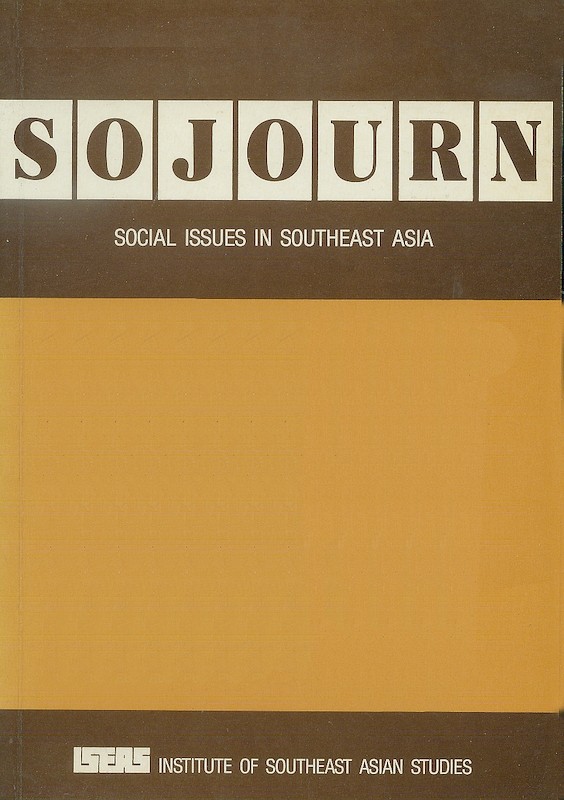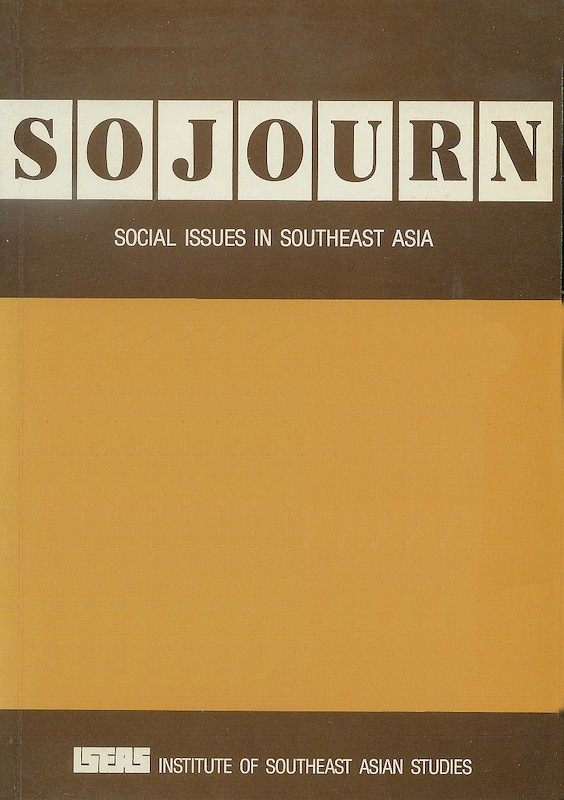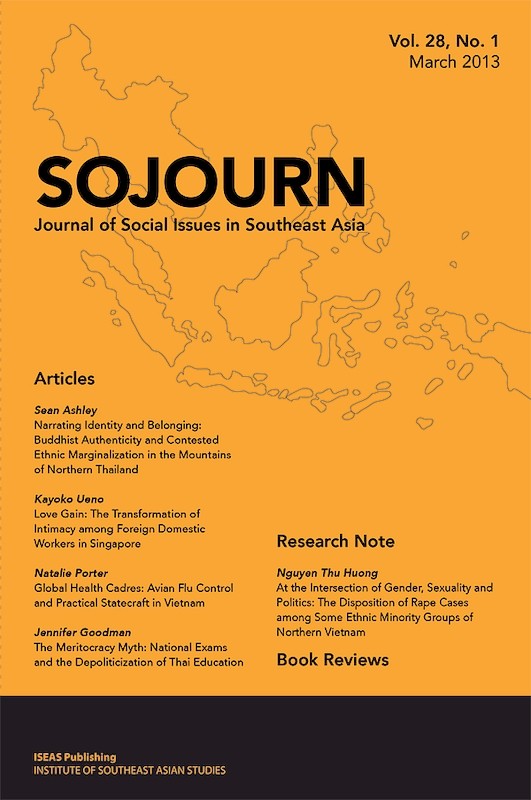SOJOURN: Journal of Social Issues in Southeast Asia Vol. 8/2 (August 1993)

Date of publication:
August 1993
Publisher:
Institute of Southeast Asian Studies
Number of pages:
164
Code:
SJ8/2
Contents
-
Preliminary pages
- ARTICLES
-
The Role of Ethnic Relations and Education Systems in Migration from Southeast Asia to Australia, by Gerard Sullivan, Subbiah Gunasekaran, authors see abstractThis article describes the pattern of Southeast Asian migration to Australia and analyses the role of structural factors, such as ethnic diversity, as determinants of emigration. A short history of Asian immigration to Australia which discusses Australian government policy towards Asian immigrants is followed by a stock analysis of Asian-born residents in Australia which compares their socioeconomic and demographic characteristics with the total Australian population. Flow data provide a picture of contemporary Hong Kong and Southeast Asian migration to Australia between July 1983 and May 1988 Ethnic relations and political-economic circumstances in these sending countries are examined as motivating factors for emigration. Potential emigrants from Singapore and Malaysia report that concerns about the long-term economic and political security and stability of small states are very important Besides these factors, educational and career opportunities for their children are primary among their considerations Many emigrants exhibited a sophisticated knowledge of their likely place in Australian society and have formulated strategies to cope with likely adversities. Many are prepared to accept downward occupational mobility which is compensated in part by better opportunities for their children and greater earning power.
-
Economic Change and Public Health in a Remote Sarawak Community, by Jennifer Alexander, Paul Alexander, authors see abstractPhysical health standards in remote Sarawak communities have been raised by a series of public health measures including the virtual elimination of formerly widespread diseases, improved maternal and child care, lower infant mortality, and rapid treatment of illness and injuries. But these undoubted successes should be contextualized by situating public health interventions within the broader processes of economic and social change that are rapidly transforming such communities. From the point of view of the Lahanan, a small group of horticulturalists living on the upper reaches of the Rejang River, each welcomed benefit has had a concomitant cost new needs have been created faster than the means to satisfy them.
- RESEARCH NOTES AND COMMENTS
-
Women's Search for a Place in Public Life in Singapore, by Seet Ai Mee, author see abstractThis research note briefly examines the changing nature and place of women in public and political life in Singapore. The scope of this discussion is limited to the level of women's participation in the work-force, trade unions, tertiary institutions, grassroots organizations, political parties, and government administration. It concludes that while women play a crucial role in work and public life in Singapore, they are still under-represented at the highest levels of administrative, work, and political echelons.
-
Trends and Differentials in Female Age at First Marriage in Thailand over Half a Century, by Jutamas Wayachut, author see abstractThis research note examines birth cohort trends and differentials in age at first marriage based on the sample data of the 1980 Population and Housing Census of Thailand Previous studies have compared the singulate mean age at marriage (SMAM) obtained from censuses and surveys in order to describe changes in the timing of marriage in Thailand. There are, however, some limitations in the use of SMAM towards this end Some observations about differences in the age at marriage for different regions, urban/rural contexts, and religious and educational groups are also offered.
-
Twice as Less, lah: Language, Logic, and Economic Development, by Peter A Coclanis, author see abstractEmploying recent research from the West, the author argues that the relationship between verbal skills, on the one hand, and science and maths skills, on the other, is closer than many scholars acknowledge. He suggests that the relatively poor performance of Singaporean students in international comparisons of scientific and mathematical achievement may be related to logical problems in Singapore English. He urges further research into the matter, which is important to Singapore's further economic development.
-
Adventures and Misadventures of the New Sufis: Islamic Spiritual Groups in Contemporary Malaysia, by John Bousfield, author see abstractRather than focusing on the Malaysian dakwah movement in general, attention is given to the specific appeal of contemporary Sufi or spiritually inclined Muslim groups. It is argued that their appeal is best characterized in more positive and dynamic terms than is often the case. Their position vis-a-vis "orthodoxy" recapitulates that of earlier Sufi movements. Particular attention is given to how the teachings and practices become labelled "deviant" and what consequences follow. The discussion draws sometimes upon the experience of the author in autobiographical fashion to uncover a "politics of versions".
-
Modernity, State, and Religion: Theoretical Notes towards a Comparative Study, by Hasan Unal Nalbantoglu, author see abstractThis note attempts to discuss certain salient points that emerged from the controversies on the so-called crisis of modernity in recent times, pointing to their relevance in the case of developing countries, particularly with respect to the spheres of state, civil society, and religion. The theoretical insights from past sociological, historical, and philosophical literature are deployed in coming to grips with the challenging questions posed by the current dynamics of the above-mentioned spheres in the developing world. The case of the Ottoman Empire and the theoretical-ideological tendencies within modern Turkish historiography that have been used to approach this historical phenomenon are provided as particular examples to support the argument.
- BOOK REVIEWS
-
BOOK REVIEW: No Money, No Honey: A Study of Street Traders and Prostitutes in Jakarta. By Alison J Murray, by Susan Blackburn, author
-
BOOK REVIEW: Thai Constructions of Knowledge. Edited by Manas Chitakasem and Andrew Turton., by Peter Vandergeest, author
-
BOOK REVIEW: Seductive Mirage: The Search for Community in Southeast Asia. By Jeremy Kemp., by Peter Vandergeest, author
- CONFERENCES, WORKSHOPS, AND SEMINARS
-
Discussion on Segita Pertumbuhan SIJORI/JSR Growth Triangle, 12 April 1993, Institute of Southeast Asian Studies, Singapore; International Conference on Design and Development for a Sustainable Future, 3-4 June 1993, Kuala Lumpur, Malaysia
-
Index to SOJOURN: Social Issues in Southeast Asia, vol. 8 (1993)






